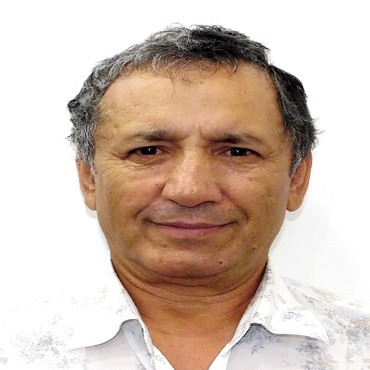Scientific Program
Keynote Session:
A PHP Error was encountered
Severity: 8192
Message: trim(): Passing null to parameter #1 ($string) of type string is deprecated
Filename: pastconference/past-program-schedule.php
Line Number: 239
Backtrace:
File: /efsdata/meetingsint-com/application/views/pastconference/past-program-schedule.php
Line: 239
Function: trim
File: /efsdata/meetingsint-com/application/controllers/Pastconference.php
Line: 128
Function: view
File: /efsdata/meetingsint-com/index.php
Line: 317
Function: require_once
Title: A powerful explosion of light and the synthesis of porous nanomaterial
Biography:
Abstract:
Title: Intentional vacuum annealing induced, surfactant-initiated surprising carbon doping @ zinc oxide decorated graphitic carbon nano fiber hybrid thin films for Interfacial Stress-Grading Applications
Biography:
G.R. Dillip is an INSPIRE Faculty in the Solid State and Structural Chemistry Unit, Indian Institute of Science, India. Previously, he was worked as an Assistant Professor in the School of Mechanical Engineering, Yeungnam University, South Korea. He finished his Ph.D. Degree in Physics from Sri Venkateswara University, India in 2013 and after that he joined at Yeungnam University, South Korea. He has authored ~40 scientific articles in various reputed International Journals, a Book Chapter and also presented his work in both National and International Conferences and participated in several Workshops. He also registered a Korean Patent. His research interests include various defect-mediated studies of carbon based metal oxide nanocomposites/hybrids for energy-related applications (such as Supercapacitors/Batteries) and also rare-earth doped optical materials for solid state lighting devices.
Abstract:
Title: Lanthanides-Graphene Oxide Nanocomposites for Sustainable Groundwater Remediation
Biography:
Abstract:
A PHP Error was encountered
Severity: 8192
Message: trim(): Passing null to parameter #1 ($string) of type string is deprecated
Filename: pastconference/past-program-schedule.php
Line Number: 239
Backtrace:
File: /efsdata/meetingsint-com/application/views/pastconference/past-program-schedule.php
Line: 239
Function: trim
File: /efsdata/meetingsint-com/application/controllers/Pastconference.php
Line: 128
Function: view
File: /efsdata/meetingsint-com/index.php
Line: 317
Function: require_once
Title: Microwave irradiation: In-situ conversion of nanoflakes to nanoflowers of ZnCo2O4 on Ni foam for enhanced electro-catalytic activity
Biography:
Dr. Sreekanth received his PhD in Chemistry from S.V. University, India, in 2009, under the supervision of Prof. K.S. Reddy. Afterthat, he joined as an Assistant Professor in the Department of Chemistry, Dongguk University, Gyeongju, South Korea, Later, he moved to College of Mechanical Engineering, Yeungnam University, South Korea. His research interests include metal / metal oxide nanoparticles for Catalytic applications. His recent research activities focus on electrochemical energy storage.
Abstract:
Spinel structure metal oxides provides the effective performance towards the electro-catalytic analysis. Among the spinel structure metal oxides, ZnCo2O4 has effective in the area of photocatalyst, gas sensor, li-ion batteries, supercapacitors and electro-oxidation. The performance of direct methanol fuel cells hinges on the activity of the catalyst. To enhance the electro-catalytic activity, a flower-like nanostructure of ZnCo0O4 assembled on nickel foam (NF) via microwave irradiation process, the whole process was finished within 15 min. The ZnCo2O4 nanoflower is successfully applied in the electro-catalytic oxidation of methanol and its electro-catalytic performance is investigated by cyclic voltammetry, chronoamperometry and electrochemical impedance spectroscopy, which exhibits excellent electro-catalytic activities towards methanol electro-oxidation in alkaline medium, including low onset potential (0.45 V), high current densities (222.3 mA cm-2) at 0.70 V (vs. SCE), and desirable electro-oxidation stability (91%) after 500 cycles in the presence of 1.0 M KOH mixed with 0.5 M methanol. The electrochemical oxidation of MeOH was also observed at higher concentration of MeOH up-to 4.0 M (0.5, 1.0, 2.0, 3.0 and 4.0 moles). The high electrochemical performance is mainly attributed to faster ion/electron transfer and an enhanced electrochemical kinetics. The present simple, and cost-effective synthesis approach can open new era for large-scale applications of the novel materials for different electrochemical applications
Oral Session 1:
- Invention And Innovation Of New Concepts In The Field Of Advance Material

Chair
Kholmurad Khasanov
Moscow State Lomonosov University, Russia

Co-Chair
Gowra Raghupathy Dillip
Indian Institute of Science, India.
Title: Lanthanides-Graphene Oxide Nanocomposites for Sustainable Groundwater Remediation
Biography:
Abstract:
A PHP Error was encountered
Severity: 8192
Message: trim(): Passing null to parameter #1 ($string) of type string is deprecated
Filename: pastconference/past-program-schedule.php
Line Number: 354
Backtrace:
File: /efsdata/meetingsint-com/application/views/pastconference/past-program-schedule.php
Line: 354
Function: trim
File: /efsdata/meetingsint-com/application/controllers/Pastconference.php
Line: 128
Function: view
File: /efsdata/meetingsint-com/index.php
Line: 317
Function: require_once
Title: Silver nanoparticles disrupt germline stem cell maintenance in the Drosophila testis
Biography:
Dr. Baeg Gyeong Hun completed his Ph.D. in Biomedical Science at the Osaka University School of Medicine, Japan and his Postdoctoral studies at Harvard Medical School, Boston. He has also worked as an Assistant Professor in the Department of Pediatrics at New York Medical College, USA. He is currently working as an Assistant professor in the Department of Anatomy at the National University of Singapore, Singapore.
Abstract:
Silver nanoparticles (AgNPs), one of the most popular nanomaterials, are commonly used in consumer products and biomedical devices, despite their potential toxicity. Recently, AgNP exposure was reported to be associated with male reproductive toxicity in mammalian models. However, there is still a limited understanding of the effects of AgNPs on reproduction, particularly on spermatogenesis. The fruit fly Drosophila testis can serve as an excellent in vivo model to elucidate the mechanisms underlying AgNP-induced defects in spermatogenesis, as germ lineages can be easily identified, traced and imaged. In this study, we evaluated AgNP-mediated toxicity on spermatogenesis by feeding Drosophila with AgNPs at various concentrations. We first observed a dose-dependent uptake of AgNPs in vivo. Concomitantly, AgNP exposure caused a significant decrease in the viability and delay in the development of Drosophila in a dose-dependent manner. Furthermore, AgNP-treated male flies showed a reduction in fecundity, and the resulting testes contained a decreased number of germline stem cells (GSCs) compared to controls. Interestingly, testes exposed to AgNPs exhibited a dramatic increase in the levels of reactive oxygen species and showed precocious GSC differentiation. Taken together, our study suggests that AgNP exposure may increase ROS levels in the Drosophila testis, leading to a reduction of GSC number by promoting premature GSC differentiation.
A PHP Error was encountered
Severity: 8192
Message: trim(): Passing null to parameter #1 ($string) of type string is deprecated
Filename: pastconference/past-program-schedule.php
Line Number: 354
Backtrace:
File: /efsdata/meetingsint-com/application/views/pastconference/past-program-schedule.php
Line: 354
Function: trim
File: /efsdata/meetingsint-com/application/controllers/Pastconference.php
Line: 128
Function: view
File: /efsdata/meetingsint-com/index.php
Line: 317
Function: require_once
Title: Application of Encapsulated Zero-Valent Iron on the Treatment of Cr(VI) in the Presence of Different Contaminants
Biography:
Prof. Yoon-Young Chang is a Professor at Kwangwoon University, Seoul, Korea. His major is Environmental engineering, especially, physicochemical treatment of water and soil containing toxic heavy metals and organic pollutants. He has also made significant contribution in the development of an advanced technologies and reactive materials for surface and ground water remediation along with soil remediation. He has more than 150 publications in peer-reviewed international journals and more than 200 reports in international and national conferences.
Abstract:
The increasing contamination of urban and industrial wastewaters by toxic metal ions is a worrying environmental problem. Among them, Chromium (Cr) is a kind of redox-sensitive pollutants. Especially, hexavalent chromium (Cr(VI)) is known as carcinogen,1 which is relatively toxic compared to trivalent chromium(Cr(III)).2 Nano zero-valent iron (nZVI) has been proven to be an effective material for the reductive precipitation of Cr(VI).3 Inside the reactive barriers, both Fe0 and the Fe2+ can be released from aerobic corrosion of Fe0 as well as redox reaction between Fe0 and Cr(VI). The reduced chromium (Cr(III)) can be precipitated as Cr(OH)3 or chromium-iron oxides / hydroxides / oxyhydroxides on the Fe0 surface.4,5 But, nZVI is easy to corrode by environmental impact due to its rapid reactivity. Considering this property, modification of nZVI is strongly needed. One of the modification methods is encapsulation of nZVI with polymeric material. The microcapsule containing nZVI can exhibit sustained releasing characteristics to enhance the stability and persistence of nZVI. Encapsulation is expected to ensure better contacts between contaminants and encapsulated nanoparticles. In addition successful encapsulation of nZVI is expected to lead to the development of more effective and robust environmental remediation techniques involving co-encapsulation of nanoparticles. The objective of this study is to examine the effectiveness of the encapsulated iron nanoparticles (@nZVI) for the treatment of wastewater contaminated with chromate. Furthermore, when the Cr(VI) is present together with various ions in the water, the reaction characteristics of the nZVI are also investigated. The @nZVI before and after reaction with chromium is characterized using X-ray photoelectron Spectroscopy (XPS), X-ray diffraction (XRD), Fourier transformer infrared spectroscopy (FT-IR) and Scanning Electron Microscope (SEM). Batch experiments are performed to investigate the effects of pH, Cr(VI) concentration, contact time and co-presented inorganic species on the removal kinetic and removal efficiency of Cr(VI) by @nZVI.
A PHP Error was encountered
Severity: 8192
Message: trim(): Passing null to parameter #1 ($string) of type string is deprecated
Filename: pastconference/past-program-schedule.php
Line Number: 354
Backtrace:
File: /efsdata/meetingsint-com/application/views/pastconference/past-program-schedule.php
Line: 354
Function: trim
File: /efsdata/meetingsint-com/application/controllers/Pastconference.php
Line: 128
Function: view
File: /efsdata/meetingsint-com/index.php
Line: 317
Function: require_once
Title: Electrochemical Biosensor for Virus Detection
Biography:
Ankan Dutta Chowdhury has completed his PhD in the year of 2015 from Saha Institute of Nuclear Physics, under Calcutta University. Later he did 2 years Postdoctoral Studies from National Chiao Tung University, Taiwan. Currently, he has been working as JSPS Postdoctoral fellow in Shizuoka University, Japan. He has published more than 20 papers in peer reviewed journals and two book chapters.
Abstract:
Viruses are a major cause of human diseases which needs an early detection to prevent an outbreak. The development of biosensor would ideally produce a quantitative signal for individual viral particles. In this work, a pulse-triggered ultrasensitive electrochemical sensor has been fabricated using graphene quantum dots (Ankan Dutta Chowdhury and Ruey-an Doong) and gold-embedded polyaniline nanowires, prepared via interfacial polymerization and then self-assembly approach (Ankan Dutta Chowdhury, Rupali Gangopadhyay and Amitabha De). Introducing an external electrical pulse during the virus accumulation step increases the sensitivity towards viruses due to the expanded surface of the virus particle as well as the antibody-conjugated polyaniline chain length, compared to other conventional electrochemical sensors (Ankan Dutta Chowdhury, Kenshin Takemura, Tian-Cheng Li, Tetsuro Suzuki and Enoch Y. Park). Under optimal condition, the proposed biosensor demonstrates its ability to detecting viruses in a wide linear range with a low detection limit of 96.7 copies mL-1. In addition, the virus samples that collected from cell culture supernatant and fecal specimens of infected monkey were also used to confirm its applicability. The sensitivity is similar with that detected by real-time quantitative reverse transcription-polymerase chain (RT-qPCR). The result suggests that the proposed sensor can pave the way for the development of robust, high-performance sensing methodologies for virus detection.
A PHP Error was encountered
Severity: 8192
Message: trim(): Passing null to parameter #1 ($string) of type string is deprecated
Filename: pastconference/past-program-schedule.php
Line Number: 354
Backtrace:
File: /efsdata/meetingsint-com/application/views/pastconference/past-program-schedule.php
Line: 354
Function: trim
File: /efsdata/meetingsint-com/application/controllers/Pastconference.php
Line: 128
Function: view
File: /efsdata/meetingsint-com/index.php
Line: 317
Function: require_once
Title: Organoclay Hybrid Materials based on clay minerals and nonionic surfactants as interesting adsorbents in water remediation
Biography:
Jae-Kyu Yang is a physico-chemist of the soft condensed matter and is interested in the stability and the microstructures generated from the mixtures of inorganic particles associated with membranes phases made of organic moieties (surfactants, lipids and other biological systems). Such association of different colloidal objects represent original routes for the preparation of nanomaterials showing environmental applications for instance.










